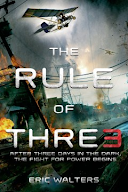Author: Susan Beth Pfeffer
Title: Life as We Knew It
Genre: Young Adult Science Fiction
Publication Date: October, 2006
Number of Pages: 337
Geographical Setting: suburb of Pennsylvania
Time Period: Present day over a period of 11 months
(May-March)
Series (If applicable): “Life
As We Knew It Series” (Book #1 of 4)
Plot Summary: Told through the protagonist’s diary entries, readers come face to face with the impact of natural disaster on an intimate, micro-level. Sixteen-year-old Miranda starts out as the typical teenager, whose life centers around grades, friendships, and her relationships with family members. Her world is turned upside down when an asteroid collides with the moon, setting into motion a series of natural disasters with unparalleled consequences. Miranda documents her family’s hardships and their heroic struggle to survive amidst extreme food shortages, illnesses, and extreme weather.
Subject Headings:
Natural disasters—Fiction
Family life—Fiction
Diaries—Fiction
Science fiction
Appeal:
Pacing – This is a fast-paced read that invites
readers to journey with the protagonist through her diary entries. The author
successfully creates a sense of drudgery as experienced by the characters while
still moving the story along at a quick pace. Even when the action is at a
standstill, the story continues to move along.
Characterization – The protagonist in this novel is
in many ways the prototypical teenage girl. Readers develop a connection to
this likeable and identifiable narrator as she journeys from a self-absorbed teen
to an emerging self-actualized young adult. Readers will root for Miranda as
she struggles with adult-sized challenges. Secondary characters include her two
brothers and mother, and we learn about her and witness her growth in maturity
through her interactions with secondary characters.
Story Line – This story follows the typical “coming-of-age”
tale ubiquitous to the YA format. Readers watch Miranda transform from an
immature teen to an emerging young adult coming to an awareness that life is much
more than her “internal and self-contained” (Brookover, et. al., 2013, p. 43)
world. The story also contains an element of “ephemeral romance” (p.43) as Miranda
finds and then lets go quickly of a love interest.
Setting/Frame (Detail) – The author creates a shroud
of darkness throughout the story through descriptions of the loss of
electricity, the biting cold, and the constant gray skies. Miranda notes that
she can never tell what time of day it is due to the constant presence of volcanic
ash. Almost daily diary entries which describe illness, malnourishment, and growing
disquiet frame the story.
Language – Pfeffer utilizes an accessible writing
style that appeals to teen readers. She has command of teen psychology and
development and presents this through realistic dialog and internal musings of
the protagonist.
Tone – The tone of this book is integral to its
appeal. There is a strong element of hopelessness interspersed with moments of
relief and hope. The readers is continually turning the page in an attempt to
uncover some light in the darkness.
3 terms that best describe this book: bleak, compelling, emotionally-intense
Similar Authors and Works:
Fiction
Ashfall by Mike Mullin – This book centers
around a teen who goes into “survival-mode” after a disastrous volcanic
eruption destroys the world he once knew. Also a sci-fi novel, Ashfall shares
the fast pace, bleak tone, and compelling writing style of Life As We Knew
It.
The Rule of Thre3 by Eric Walters – This sci-fi
young adult novel stars a teen protagonist and follows his journey of survival
after a viral catastrophe shuts down the world’s technology. The tone is bleak
and the pace is fast.
Not a Drop to Drink by Mindy McGinnis – The teen
protagonist in this novel must force herself to work with community members to
sustain life. This is reminiscent of themes in Pfeffer’s novel related to low resource
supplies and the need to ration. The two novels demonstrate the meaning of
survival. The novels share a compelling writing style and an authentic protagonist.
Nonfiction
Into Thin Air by Jon Krakauer – A bestselling survival story, this book depicts the author’s spring 1996 trek to Mt. Everest, a disastrous expedition that claimed the lives of eight climbers and explains how Krakauer survived. Readers who enjoyed the survival components of Life as We Knew It” will appreciate this highly narrative nonfiction piece.
Alive by Piers Paul Read – This disturbing
account details the struggles and sufferings of a group of young
Uruguayans during the ten weeks following an airplane crash in the Andes.
It depicts the effects of starvation and malnutrition, a topic also present in
Pfeffer’s novel. Both books treat the topic of survival. The writing style is
accessible for teen readers.
Voices from Chernobyl by Svetlana Aleksievich – This
book is described as an adult book for young adult readers. In it, Aleksievich recounts
interviews with several victims of the Chernobyl nuclear disaster. Readers interested
in how disasters (natural or otherwise) affect individuals, groups, and nations
will take keen interest in these firsthand accounts.
References
Brookover, S., Burns, E., & Jensen, K. (2014). What’s
New About New Adult? Horn Book Magazine, 90(1), 41–45.







Your nonfiction works you've picked are all heavy hitters at my library. I've wanted to read both Into Thin Air and Alive for some time. I think I'd enjoy your YA pick, too!
ReplyDeleteHi Jacob! I have not read either of those nonfiction titles, but after learning more about them, they sound fascinating! I REALLY liked "Life as We Knew It." I do recommend it!
Delete